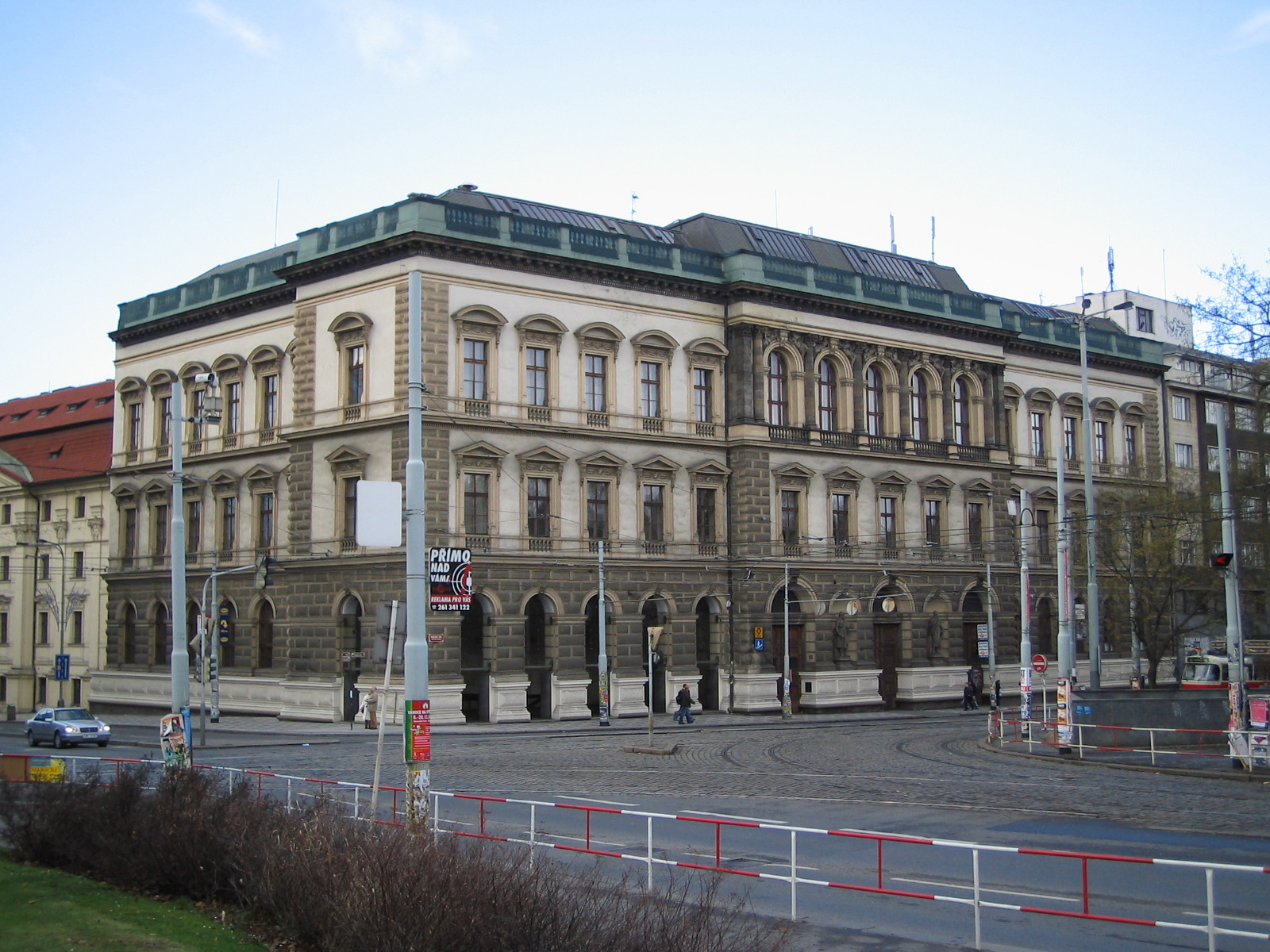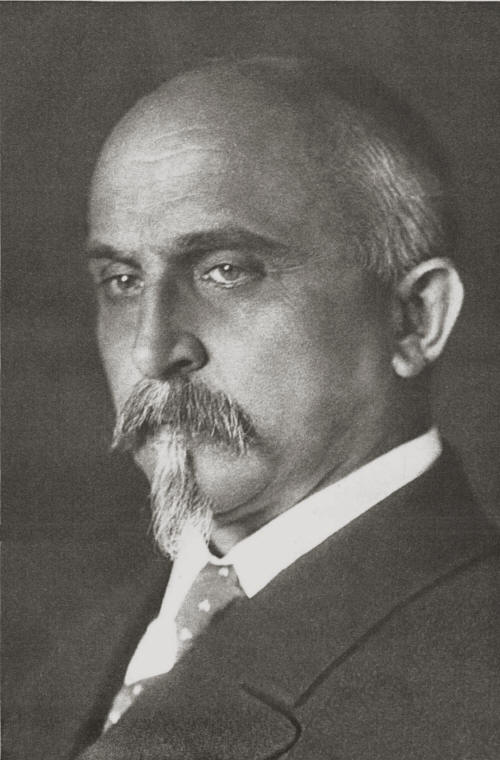|
Schebek Palace
Schebek Palace ( cs, Schebkův palác), otherwise known as "The House of the Angel", is a neo-renaissance building located at Politických vězňů 7, čp. 936/II, in New Town, Prague 1. It is protected as a cultural monument in the Czech Republic. History Prior to the construction of the current Palace, the building lot was occupied by an orphanage. It was sold to two railway magnates, Jan Schebek and František Ringhoffer, in 1868. Jan Schebek then commissioned architect Vojtěch Ignác Ullmann to design the current building. Ullmann's designs were inspired by renaissance Rome, and the building was constructed between 1870 and 1872. Originally designed to be three stories tall, additional floors have been added since the original construction. The building has four wings, with a rectangular courtyard in its center. Of special note are its ceiling murals by Viktor Barvitius, sculptures by Josef Wagner, and the building's marble staircase which leads to the first floor's main ... [...More Info...] [...Related Items...] OR: [Wikipedia] [Google] [Baidu] |
Prague 1
Prague 1, formally the Prague 1 Municipal District (), is a second-tier municipality in Prague. It is co-extensive with the national administrative district (''správní obvod'') of the same name. Prague 1 includes most of the medieval heart of the city. All of Staré Město (the Old Town) and Josefov (the Jewish Quarter) are in the district, as are most of Malá Strana (the Little Quarter), Hradčany and Nové Město (the New Town). Tiny parts of Holešovice and Vinohrady (the State Opera and new building of the National Museum) round out the district. The district has remained intact since its creation in 1960. Most of Prague 1 is a UNESCO World Heritage Site. Almost all of Prague's major tourist sites, including Prague Castle, Old Town Square, the Charles Bridge and the above-mentioned Jewish Quarter, are in the district. The Parliament of the Czech Republic and the offices of the government are in Malá Strana, while the main building of Charles University is in Staré Mě ... [...More Info...] [...Related Items...] OR: [Wikipedia] [Google] [Baidu] |
Czech Republic
The Czech Republic, or simply Czechia, is a landlocked country in Central Europe. Historically known as Bohemia, it is bordered by Austria to the south, Germany to the west, Poland to the northeast, and Slovakia to the southeast. The Czech Republic has a hilly landscape that covers an area of with a mostly temperate continental and oceanic climate. The capital and largest city is Prague; other major cities and urban areas include Brno, Ostrava, Plzeň and Liberec. The Duchy of Bohemia was founded in the late 9th century under Great Moravia. It was formally recognized as an Imperial State of the Holy Roman Empire in 1002 and became a kingdom in 1198. Following the Battle of Mohács in 1526, the whole Crown of Bohemia was gradually integrated into the Habsburg monarchy. The Protestant Bohemian Revolt led to the Thirty Years' War. After the Battle of White Mountain, the Habsburgs consolidated their rule. With the dissolution of the Holy Empire in 1806, the Cro ... [...More Info...] [...Related Items...] OR: [Wikipedia] [Google] [Baidu] |
CERGE-EI
The Center for Economic Research and Graduate Education – Economics Institute, known as CERGE-EI () is an academic institution in Prague, Czech Republic, specialised in economics. The institute is a partnership between the Center for Economic Research and Graduate Education of Charles University and the Economics Institute of the Czech Academy of Sciences. It is also a New York State Education Department entity with a permanent charter for its degree-granting educational programs awarded by the New York State Board of Regents. It is located in the Schebek Palace in the center of Prague. The center was founded in 1991 by a group that included Jan Švejnar and Jozef Zieleniec, with a goal to educate a new generation of economists from post-communist countries. The school provides an American-style PhD program in economics, a US-chartered Master of Arts program in Applied Economics (the MAE program), and the UPCES study abroad program. CERGE-EI also conducts research in theoretica ... [...More Info...] [...Related Items...] OR: [Wikipedia] [Google] [Baidu] |
Ignác Ullman
Ignác, also sometimes spelled Ignac in English, is the Hungarian version of the name Ignatius. Ignac is also a surname, among the most common surnames in the Međimurje County of Croatia. Notable people with this name include: *Ignác Alpár (1855–1928), Hungarian architect *Jozef Ignác Bajza (1755–1836), Slovak writer, satirist and Catholic priest *Ignác Batthyány (1741–1798), Hungarian Roman Catholic Bishop of Transylvania *Jan Josef Ignác Brentner (1689–1742), Czech composer of baroque era *Ignác Frank (1788–1850), Hungarian jurist and private law scholar *Ignác Goldziher (1850–1921), Hungarian orientalist *Ignác Gyulay (1763–1831), Hungarian military officer *Ignác Irhás (born 1985), Hungarian football player *Jiří Ignác Linek (1725–1791), renowned Czech late-Baroque composer and pedagogue *Ignác Raab (1715–1787), Czech Jesuit and painter *Ignác Šechtl (1840–1911), pioneer of Czech photography and cinematography *Ignác Šustala (1822–1881) ... [...More Info...] [...Related Items...] OR: [Wikipedia] [Google] [Baidu] |
Renaissance Revival Architecture
Renaissance Revival architecture (sometimes referred to as "Neo-Renaissance") is a group of 19th century architectural revival styles which were neither Greek Revival nor Gothic Revival but which instead drew inspiration from a wide range of classicizing Italian modes. Under the broad designation Renaissance architecture nineteenth-century architects and critics went beyond the architectural style which began in Florence and Central Italy in the early 15th century as an expression of Renaissance humanism; they also included styles that can be identified as Mannerist or Baroque. Self-applied style designations were rife in the mid- and later nineteenth century: "Neo-Renaissance" might be applied by contemporaries to structures that others called "Italianate", or when many French Baroque features are present (Second Empire). The divergent forms of Renaissance architecture in different parts of Europe, particularly in France and Italy, has added to the difficulty of defining an ... [...More Info...] [...Related Items...] OR: [Wikipedia] [Google] [Baidu] |
New Town, Prague
The New Town ( cs, Nové Město) is a quarter in the city of Prague in the Czech Republic. New Town is the youngest and largest of the five independent (from the Middle Ages until 1784) towns that today comprise the historic center of modern Prague. New Town was founded in 1348 by Charles IV just outside the city walls to the east and south of the Old Town and encompassed an area of 7.5 km²; about three times the size of the Old Town. The population of Prague in 1378 was well over 40,000, perhaps as much as twice that, making it the 4th most populated city north of the Alps and, by area, the 3rd largest city in Europe. Although New Town can trace its current layout to its construction in the 14th century, only few churches and administrative buildings from this time survive. There are many secular and educational buildings in New Town, but also especially magnificent gothic and baroque churches. These nevertheless are not the main drawing points for tourists. New Town's most ... [...More Info...] [...Related Items...] OR: [Wikipedia] [Google] [Baidu] |
Vojtěch Ignác Ullmann
Vojtěch Ignác Ullmann (23 April 1822 in Prague – 17 September 1897 in Příbram) was a Czech architect working in Revivalism architecture, particularly Renaissance Revival architecture. Life Ullmann studied architecture at the Academy of Fine Arts in Vienna with professors August Sicard von Sicardsburg and Eduard van der Nüll. After finishing his studies, he travelled to Italy. From 1854 he worked as an architect in Prague. He often collaborated with the architect Antonín Viktor Barvitius, whose sister he married in 1856. By 1874 he had designed a number of buildings in Prague. Design style In Ullmann's early work we see echoes of medieval stylistic elements (see the Church of Saints Cyril and Methodius in Prague 8 - Karlín). In the next phase of his work, he was significantly influenced by the Viennese renaissance school. Work Prague * Church of Saints Cyril and Methodius (Karlín), Karlínské Square. Prague 8 * Czech Polytechnic, Karlovo Square 13, Prague 1, (to ... [...More Info...] [...Related Items...] OR: [Wikipedia] [Google] [Baidu] |
National Bank Of Czechoslovakia
The National Bank of Czechoslovakia ( cs, Národní banka Československá) was the central bank of Czechoslovakia between 1926 and 1939. Between 1939 and 1945, its activities were divided into the National Bank for Bohemia and Moravia in Prague ( cs, Národní banka pro Čechy a Moravu v Praze, german: Nationalbank für Böhmen und Mähren in Prag) in the Protectorate of Bohemia and Moravia and the Slovak National Bank ( sk, Slovenská Národní Banka) in the Slovak Republic. The National Bank was re-established in reunified Czechoslovakia in 1945, and in 1950 renamed State Bank of Czechoslovakia ( cs, Státní banka československá). On , the State Bank of Czechoslovakia was replaced by its two successor entities, the Czech National Bank in the Czech Republic and the National Bank of Slovakia in Slovakia. Background Following the collapse of the Habsburg Monarchy and the Czechoslovak declaration of independence in October 1918, monetary authority under the First Czechoslova ... [...More Info...] [...Related Items...] OR: [Wikipedia] [Google] [Baidu] |
Czech Academy Of Sciences
The Czech Academy of Sciences (abbr. CAS, cs, Akademie věd České republiky, abbr. AV ČR) was established in 1992 by the Czech National Council as the Czech successor of the former Czechoslovak Academy of Sciences and its tradition goes back to the Royal Bohemian Society of Sciences (founded in 1784) and the Emperor Franz Joseph Czech Academy for Sciences, Literature and Arts (founded in 1890). The Academy is the leading non-university public research institution in the Czech Republic. It conducts both fundamental and strategic applied research. It has three scientific divisions, namely the Division of Mathematics, Physics, and Earth Sciences, Division of Chemical and Life Sciences, and Division of Humanities and Social Sciences. The Academy currently manages a network of sixty research institutes and five supporting units staffed by a total of 6,400 employees, over one half of whom are university-trained researchers and Ph.D. scientists. The Head Office of the Academy and ... [...More Info...] [...Related Items...] OR: [Wikipedia] [Google] [Baidu] |
Palaces In Prague
A palace is a grand residence, especially a royal residence, or the home of a head of state or some other high-ranking dignitary, such as a bishop or archbishop. The word is derived from the Latin name palātium, for Palatine Hill in Rome which housed the Imperial residences. Most European languages have a version of the term (''palais'', ''palazzo'', ''palacio'', etc.), and many use it for a wider range of buildings than English. In many parts of Europe, the equivalent term is also applied to large private houses in cities, especially of the aristocracy; often the term for a large country house is different. Many historic palaces are now put to other uses such as parliaments, museums, hotels, or office buildings. The word is also sometimes used to describe a lavishly ornate building used for public entertainment or exhibitions such as a movie palace. A palace is distinguished from a castle while the latter clearly is fortified or has the style of a fortification, wherea ... [...More Info...] [...Related Items...] OR: [Wikipedia] [Google] [Baidu] |




.jpg)
